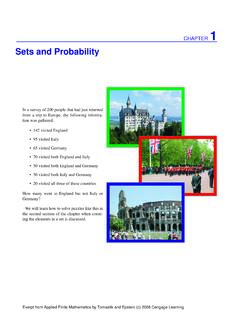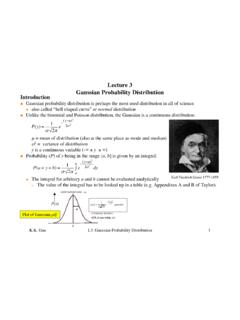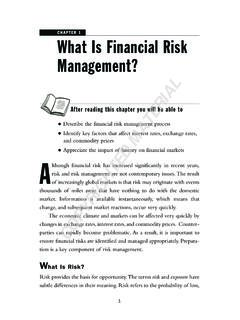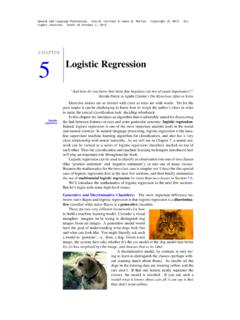Transcription of you have a candle in your hand. – JOHN ARBUTHNOT - NCERT
1 VWhere a mathematical reasoning can be had, it is as great a folly tomake use of any other, as to grope for a thing in the dark, whenyou have a candle in your hand. JOHN ARBUTHNOT IntroductionIn earlier classes, we studied about the concept ofprobability as a measure of uncertainty of variousphenomenon. We have obtained the probability of gettingan even number in throwing a die as 36 , 12. Here thetotal possible outcomes are 1,2,3,4,5 and 6 (six in number).The outcomes in favour of the event of getting an evennumber are 2,4,6 ( , three in number).
2 In general, toobtain the probability of an event, we find the ratio of thenumber of outcomes favourable to the event, to the totalnumber of equally likely outcomes. This theory of probabilityis known as classical theory of Class IX, we learnt to find the probability on the basis of observations andcollected data. This is called statistical approach of the theories have some serious difficulties. For instance, these theories cannot be applied to the activities/experiments which have infinite number of outcomes.
3 Inclassical theory we assume all the outcomes to be equally likely. Recall that the outcomesare called equally likely when we have no reason to believe that one is more likely tooccur than the other. In other words, we assume that all outcomes have equal chance( probability ) to occur. Thus, to define probability , we used equally likely or equallyprobable outcomes. This is logically not a correct definition. Thus, another theory ofprobability was developed by Kolmogorov, a Russian mathematician, in 1933.
4 He16 ChapterPROBABILITYK olmogorov (1903-1987)2022-23384 MATHEMATICS laid down some axioms to interpret probability , in his book Foundation of probability published in 1933. In this Chapter, we will study about this approach called axiomaticapproach of probability . To understand this approach we must know about few basicterms viz. random experiment, sample space, events, etc. Let us learn about these all,in what follows Random ExperimentsIn our day to day life, we perform many activities which have a fixed result no matterany number of times they are repeated.
5 For example given any triangle, without knowingthe three angles, we can definitely say that the sum of measure of angles is 180 .We also perform many experimental activities, where the result may not be same,when they are repeated under identical conditions. For example, when a coin is tossedit may turn up a head or a tail, but we are not sure which one of these results willactually be obtained. Such experiments are called random experiment is called random experiment if it satisfies the following twoconditions: (i)It has more than one possible outcome.
6 (ii)It is not possible to predict the outcome in whether the experiment of tossing a die is random or not?In this chapter, we shall refer the random experiment by experiment only unlessstated Outcomes and sample space A possible result of a random experiment iscalled its the experiment of rolling a die. The outcomes of this experiment are 1,2, 3, 4, 5, or 6, if we are interested in the number of dots on the upper face of the set of outcomes {1, 2, 3, 4, 5, 6} is called the sample space of the , the set of all possible outcomes of a random experiment is called the samplespace associated with the experiment.
7 Sample space is denoted by the symbol element of the sample space is called a sample point. In other words, eachoutcome of the random experiment is also called sample us now consider some 1 Two coins (a one rupee coin and a two rupee coin) are tossed once. Finda sample Clearly the coins are distinguishable in the sense that we can speak of thefirst coin and the second coin. Since either coin can turn up Head (H) or Tail(T), thepossible outcomes may be2022-23 probability 385 Heads on both coins = (H,H) = HHHead on first coin and Tail on the other = (H,T) = HTTail on first coin and Head on the other = (T,H) = THTail on both coins = (T,T) = TTThus, the sample space is S = {HH, HT, TH, TT}ANote The outcomes of this experiment are ordered pairs of H and T.
8 For thesake of simplicity the commas are omitted from the ordered 2 Find the sample space associated with the experiment of rolling a pair ofdice (one is blue and the other red) once. Also, find the number of elements of thissample Suppose 1 appears on blue die and 2 on the red die. We denote this outcomeby an ordered pair (1,2). Similarly, if 3 appears on blue die and 5 on red, the outcomeis denoted by the ordered pair (3,5).In general each outcome can be denoted by the ordered pair (x, y), where x isthe number appeared on the blue die and y is the number appeared on the red , this sample space is given byS = {(x, y): x is the number on the blue die and y is the number on the red die}.
9 The number of elements of this sample space is 6 6 = 36 and the sample space isgiven below:{(1,1), (1,2), (1,3), (1,4), (1,5), (1,6), (2,1), (2,2), (2,3), (2,4), (2,5), (2,6)(3,1), (3,2), (3,3), (3,4), (3,5), (3,6), (4,1), (4,2), (4,3), (4,4), (4,5), (4,6)(5,1), (5,2), (5,3), (5,4), (5,5), (5,6), (6,1), (6,2), (6,3), (6,4), (6,5), (6,6)}Example 3 In each of the following experiments specify appropriate sample space(i)A boy has a 1 rupee coin, a 2 rupee coin and a 5 rupee coin in his pocket. Hetakes out two coins out of his pocket, one after the other.
10 (ii)A person is noting down the number of accidents along a busy highwayduring a (i) Let Q denote a 1 rupee coin, H denotes a 2 rupee coin and R denotes a 5rupee coin. The first coin he takes out of his pocket may be any one of the three coinsQ, H or R. Corresponding to Q, the second draw may be H or R. So the result of twodraws may be QH or QR. Similarly, corresponding to H, the second draw may beQ or , the outcomes may be HQ or , corresponding to R, the seconddraw may be H or , the outcomes may be RH or , the sample space is S={QH, QR, HQ, HR, RH, RQ}(ii)The number of accidents along a busy highway during the year of observationcan be either 0 (for no accident ) or 1 or 2, or some other positive , a sample space associated with this experiment is S= {0,1,2.}

















